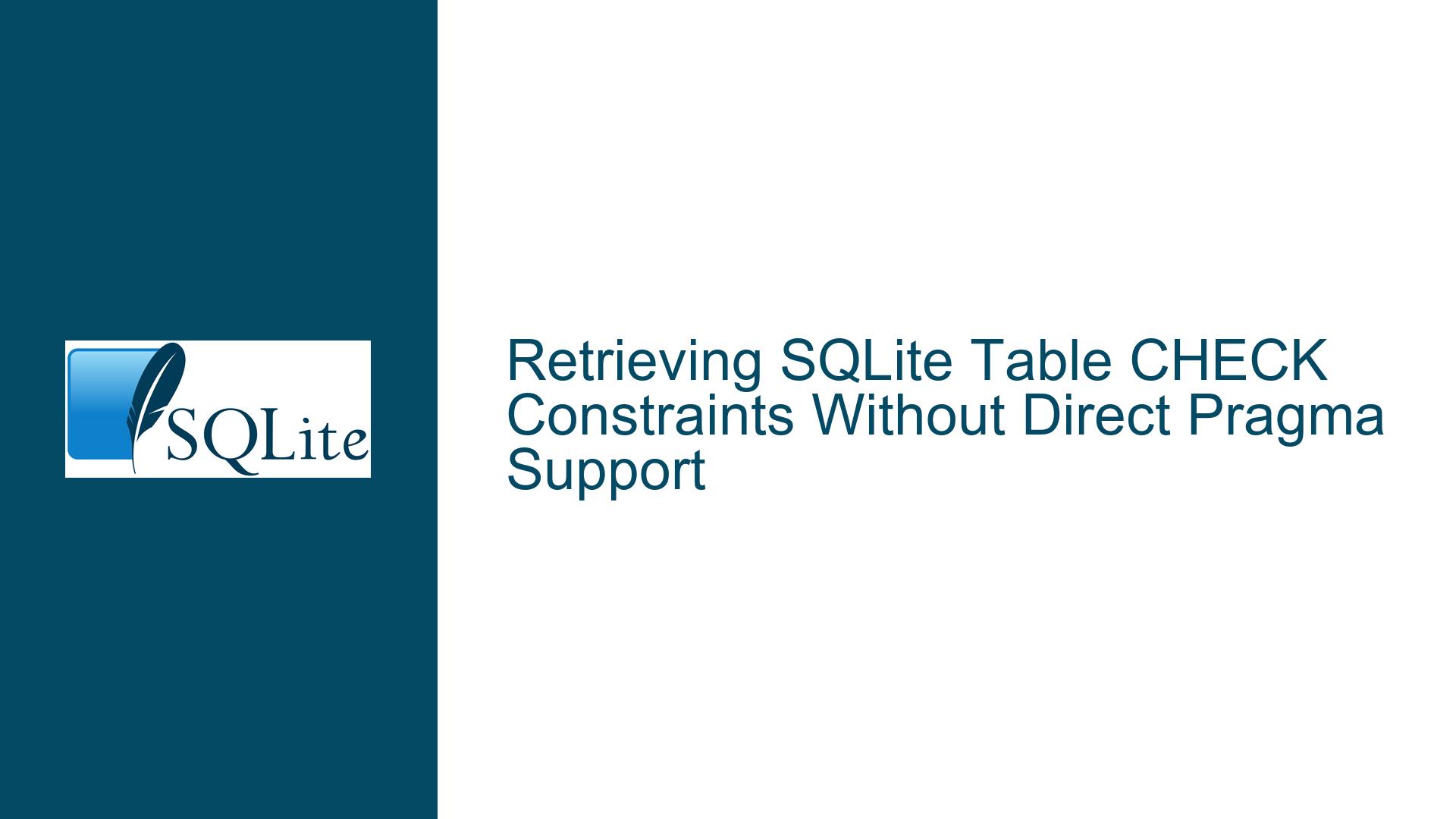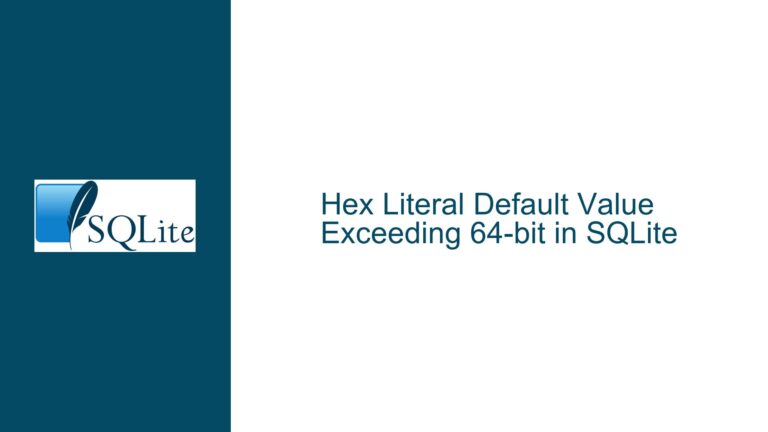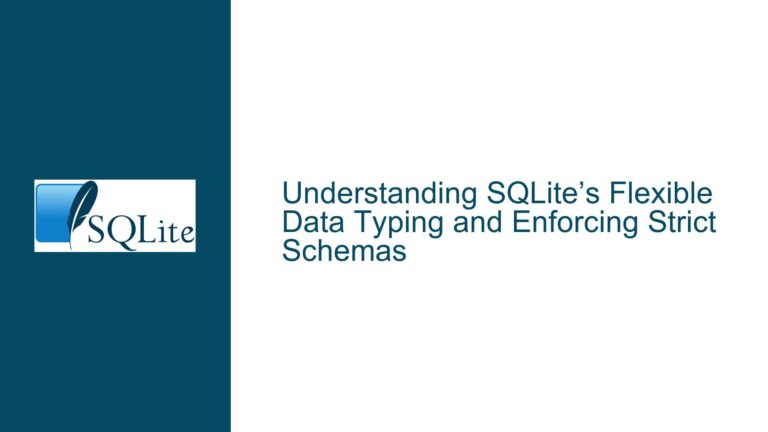Retrieving SQLite Table CHECK Constraints Without Direct Pragma Support
Understanding the Absence of Built-In CHECK Constraint Retrieval in SQLite
SQLite does not provide a direct mechanism, such as a pragma command or a metadata table, to programmatically retrieve the CHECK constraints defined on a table. This limitation stems from SQLite’s design philosophy as a lightweight, embeddable database engine that prioritizes simplicity and minimalism over exhaustive metadata introspection. Unlike other database systems like PostgreSQL or MySQL, which expose constraint details through system catalogs (e.g., information_schema), SQLite delegates the responsibility of constraint management to the schema definition itself. The CREATE TABLE statement’s original DDL (Data Definition Language) is stored in the sqlite_schema table as plain text, and CHECK constraints are embedded within this text. Consequently, SQLite assumes that applications requiring access to constraint metadata will parse the DDL directly rather than relying on precomputed metadata structures.
The absence of a dedicated pragma for CHECK constraints—such as pragma table_info, which returns column details—forces developers to adopt alternative strategies. While SQLite offers pragmas like pragma foreign_key_list for foreign keys or pragma index_list for indexes, no equivalent exists for CHECK constraints. This gap complicates tasks such as schema validation, migration scripting, or ORM (Object-Relational Mapping) implementations that rely on introspecting constraints. The lack of a standardized retrieval method also impacts tools like database explorers or schema migration frameworks, which must reconstruct constraint definitions manually. This limitation is intentional but not insurmountable, as SQLite’s schema storage model provides raw material for constraint extraction through careful parsing.
Root Causes Behind Missing CHECK Constraint Metadata Accessibility
The primary cause of SQLite’s lack of CHECK constraint introspection lies in its architecture. SQLite avoids maintaining redundant metadata structures to minimize overhead and preserve its lightweight footprint. When a table is created, the original DDL command is stored verbatim in the sqlite_schema table’s sql column. CHECK constraints are part of this DDL text but are not parsed into separate metadata tables during schema creation. This design choice reduces runtime memory usage and avoids the computational cost of maintaining auxiliary metadata. However, it shifts the burden of constraint extraction to applications, which must parse the DDL text to identify CHECK constraints.
A secondary cause is historical precedent. SQLite’s development has prioritized backward compatibility and stability over expanding metadata accessibility. Features like the table_xinfo pragma (which includes hidden columns in virtual tables) were added incrementally based on user demand. CHECK constraints, while supported since SQLite 3.3.0 (2006), have not seen equivalent tooling enhancements. The SQLite development team has historically deferred such features to extensions or third-party tools, relying on the community to address niche requirements. This approach ensures that the core database engine remains compact but leaves gaps in metadata accessibility for advanced use cases.
Another contributing factor is the complexity of parsing CHECK constraints. Unlike column names or data types, CHECK constraints can involve arbitrary expressions, nested subqueries, or references to user-defined functions. Storing parsed constraint expressions in a structured format would require a more sophisticated metadata schema, increasing the database’s complexity. SQLite’s minimalist philosophy discourages such additions unless they serve a broad majority of users. Consequently, CHECK constraint retrieval remains a "do-it-yourself" task, reliant on parsing the original DDL.
Strategies for Extracting CHECK Constraints via DDL Parsing and Workarounds
To retrieve CHECK constraints in SQLite, developers must parse the DDL text stored in the sqlite_schema table. The process involves querying the sql column for the target table’s schema, then extracting CHECK constraints using string manipulation or a formal SQL parser. For example, the following query retrieves the DDL for a table named employees:
SELECT sql FROM sqlite_schema
WHERE type = 'table' AND name = 'employees';
The resulting sql text might look like this:
CREATE TABLE employees (
id INTEGER PRIMARY KEY,
name TEXT NOT NULL,
salary REAL CHECK (salary >= 0),
department_id INTEGER,
CHECK (department_id BETWEEN 1 AND 10)
);
Parsing this text requires identifying CHECK keywords followed by parenthesized expressions. Simple cases can be handled with regular expressions, though this approach is brittle and may fail with nested parentheses or complex expressions. A more robust solution involves using a SQL parser library, such as sqlite-parser (a JavaScript tool) or Sqlite3CreateTableParser (a Python library), which tokenize the DDL and return structured output. These tools transform the raw DDL into an abstract syntax tree (AST), from which CHECK constraints can be programmatically extracted.
For environments requiring native SQLite integration, a custom extension can be developed using SQLite’s C API. This extension could register a user-defined function, such as extract_checks(table_name), which parses the DDL and returns constraint details in a tabular format. While this approach demands significant upfront development effort, it provides a reusable solution for applications that frequently introspect constraints. Alternatively, developers can advocate for SQLite enhancements by submitting patches to the SQLite core team, proposing a new pragma like pragma check_constraints(table_name) or extending pragma table_xinfo to include constraint metadata.
In the absence of official solutions, workarounds like precomputing constraint metadata during schema migration or maintaining a separate constraints registry in application code offer temporary relief. These methods require discipline to keep the metadata synchronized with the actual schema but avoid runtime parsing overhead. For tools and frameworks, integrating a DDL parser as a dependency ensures accurate constraint extraction without relying on SQLite’s limited introspection capabilities. Ultimately, the choice of strategy depends on the application’s requirements: ad-hoc debugging may suffice with regex-based parsing, while mission-critical systems warrant investing in a dedicated parser or extension.






